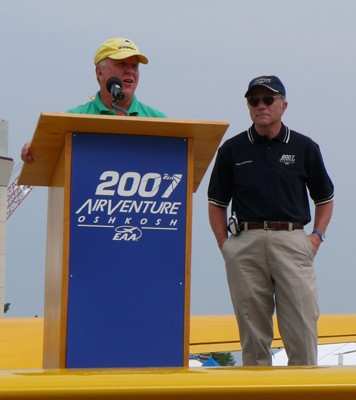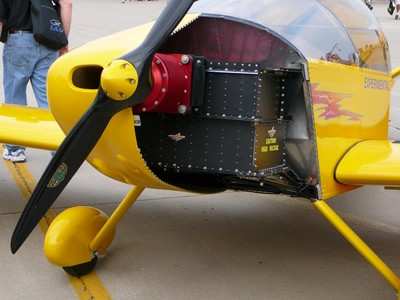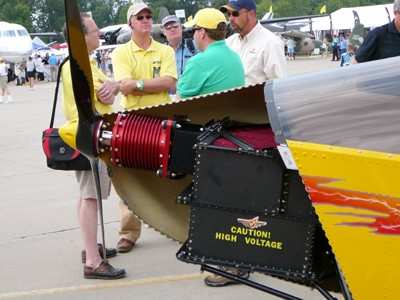Plug and Play - And It's Good For The Environment
The crowd surrounded the small yellow Sonex plane at AeroShell
Square, waiting for answers. Electric? Ethanol? What will Sonex
Founder and President John Monnett would be announcing at Tuesday's
press conference about his company's E-Flight Initiative?

Following company accolades by Tom Poberezny concerning the
company's craftsmanship and its endeavors to improve and grow
aviation in the future, Monnett took to the podium and made it
officia --l by introducing the proof of concept prototype electric
motor powerplant, controller, battery pack and charging systems
installed in a Waiex airframe.
The proof-of-concept looks exactly like a Sonex from the
outside, but uses the alternative energy source.
And for the ethanol crowd, he noted AeroConversion's
investigation of converting its versions Aero Vee 2.0 powerplant
for use of both ethanol-based fuels. More on that Wednesday,
though.
The goal of the electric proof-of-concept, according to Sonex,
is to determine the feasibility of a marketable line of Sonex and
prototype products.
With the current Sonex staff focused on customer service and
sales, it was only a small group of folks from AeroConversion who
focused their energies on the new concept, which only took six
months from idea to concept plane.
The current non-electric Sonex is a kit-based, basic all-metal
two place monoplace suited for the US Sport Pilot.
And for those looking under the cowling to see which company's
battery was being used in the proof-of-concept, they were
disappointed.

Noted Sonex's Director of Public Relations Mark Schaible, the
motor and battery system named no names: "They are proprietary
parts we are in the process of developing."
The motor, said Schaible, is more than 90 percent efficient...
and the most powerful of its kind. In regard to battery power, most
contemporary electric powerplants for gas-electric and pure
electric cars and previous generations of RC electric vehicles
utilize Lithium Ion battery technology.
While much improved in power density and discharge rate over
lead-acid and NiCad batteries, Li-Ion batteries still do not offer
sufficient power discharge-to-weight ratio to support an electric
powerplant for an aircraft based on battery power alone with
market-viable endurance.
Newer RC electric vehicles, cell phones, laptop computers and
other mobile devices have been moving toward Lithium Polymer cells,
which can safely discharge at a rate of 25 times their capacity, or
"25c."
The so-called "E-Flight Team" engineered and constructed 10
battery "safe boxes" to contain eight Li-Poly battery packs per box
and consolidate their charge/discharge and balancing wiring into
two sets of multi-pin connectors.
The boxes will accommodate natural cell expansion and
contraction while safely securing each cell pack and facilitating
cell cooling with "cooling foam" padding. The boxes are designed to
contain and safely direct fire or explosion within the box through
a "blow hole" in the box connected to a small exhaust manifold.
For the proof-of-concept plane, the battery boxes are removed
and charged individually.
Further generations of safer, more powerful Li-Poly batteries
show the near-term possibility of further extended flight
durations, from the current 45 minutes to one hour, while personal
electronics and transportation will undoubtedly continue to push
improvement of the technology in years to come.

And now to the big questions. When will an actual kit plane be
available to the public and how much will it cost? As with any
proof-of-concept, company representatives were unable to share
specific timelines
However, said Schaible, "We don't want to take too long and we
don't want to put out artificial deadlines."
And in regard to price? "Any (final) product will be vastly less
expensive than other things out there." In fact, said Schaible, the
entire research and development for the project is less than the
cost of a ready-to-fly LSA.
A follow-up informational forum is open to the public Wednesday,
July 25 at 11:30 am at AirVenture forum building 11.
Founded in 1998, Sonex Aircraft has been providing a series of
Sport Pilot-eligible kit aircraft and producing the
AeroConversions' line of products that include Aero Vee engine,
AeroCarb, and ancillary aviation products.
 Aero-News: Quote of the Day (04.28.25)
Aero-News: Quote of the Day (04.28.25) ANN's Daily Aero-Term (04.28.25): Decision Altitude (DA)
ANN's Daily Aero-Term (04.28.25): Decision Altitude (DA) ANN's Daily Aero-Linx (04.28.25)
ANN's Daily Aero-Linx (04.28.25) Airborne-Flight Training 04.24.25: GA Refocused, Seminole/Epic, WestJet v TFWP
Airborne-Flight Training 04.24.25: GA Refocused, Seminole/Epic, WestJet v TFWP Aero-News: Quote of the Day (04.29.25)
Aero-News: Quote of the Day (04.29.25)





